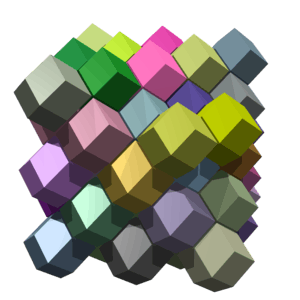Rhombic dodecahedral honeycomb
| Rhombic dodecahedral honeycomb | |
|---|---|
 | |
| Type | convex uniform honeycomb dual |
| Coxeter-Dynkin diagram | |
| Cell type | Rhombic dodecahedron V3.4.3.4 |
| Face types | Rhombus |
| Space group | Fm3m (225) |
| Coxeter notation | ½ , [1+,4,3,4] , [1+,4,3,4] , [4,31,1] , [4,31,1] ×2, <[3[4]]> ×2, <[3[4]]> |
| Dual | tetrahedral-octahedral honeycomb |
| Properties | edge-transitive, face-transitive, cell-transitive |
The rhombic dodecahedra honeycomb is a space-filling tessellation (or honeycomb) in Euclidean 3-space. It is the Voronoi diagram of the face-centered cubic sphere-packing, which is believed to be the densest possible packing of equal spheres in ordinary space (see Kepler conjecture).
It consists of copies of a single cell, the rhombic dodecahedron. All faces are rhombi, with diagonals in the ratio 1:√2. Three cells meet at each edge. The honeycomb is thus cell-transitive, face-transitive and edge-transitive; but it is not vertex-transitive, as it has two kinds of vertex. The vertices with the obtuse rhombic face angles have 4 cells. The vertices with the acute rhombic face angles have 6 cells.
The rhombic dodecahedron can be twisted on one of its hexagonal cross-sections to form a trapezo-rhombic dodecahedron, which is the cell of a somewhat similar tessellation, the Voronoi diagram of hexagonal close-packing.

References
- Williams, Robert (1979). The Geometrical Foundation of Natural Structure: A Source Book of Design. Dover Publications, Inc. p. 168. ISBN 0-486-23729-X.
External links
| Wikimedia Commons has media related to Rhombic dodecahedral honeycomb. |
- Weisstein, Eric W., "Space-filling polyhedron", MathWorld.
- Examples of Housing Construction using this geometry